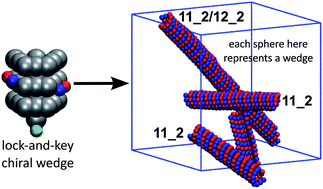Self-assembly of chiral tubules†
Abstract
The efficient and controlled assembly of complex structures from macromolecular building blocks is a critical open question in both biological systems and nanoscience. Using molecular dynamics simulations we study the self-assembly of tubular structures from model macromolecular monomers with multiple binding sites on their surfaces [Cheng et al., Soft Matter, 2012, 8, 5666–5678]. In this work we add chirality to the model monomer and a lock-and-key interaction. The self-assembly of free monomers into tubules yields a pitch value that often does not match the chirality of the monomer (including achiral monomers). We show that this mismatch occurs because of a twist deformation that brings the lateral interaction sites into alignment when the tubule pitch differs from the monomer chirality. The energy cost for this deformation is small as the energy distributions substantially overlap for small differences in the pitch and chirality. In order to control the tubule pitch by preventing the twist deformation, the interaction between the vertical surfaces must be increased without resulting in kinetically trapped structures. For this purpose, we employ lock-and-key interactions and obtain good control of the self-assembled tubule pitch. These results explain some fundamental features of microtubules. The vertical interaction strength is larger than the lateral in microtubules because this yields a controlled assembly of tubules with the proper pitch. We also generally find that the control of the assembly into tubules is difficult, which explains the wide range of pitch values and protofilament numbers observed in microtubule assembly.


 Please wait while we load your content...
Please wait while we load your content...